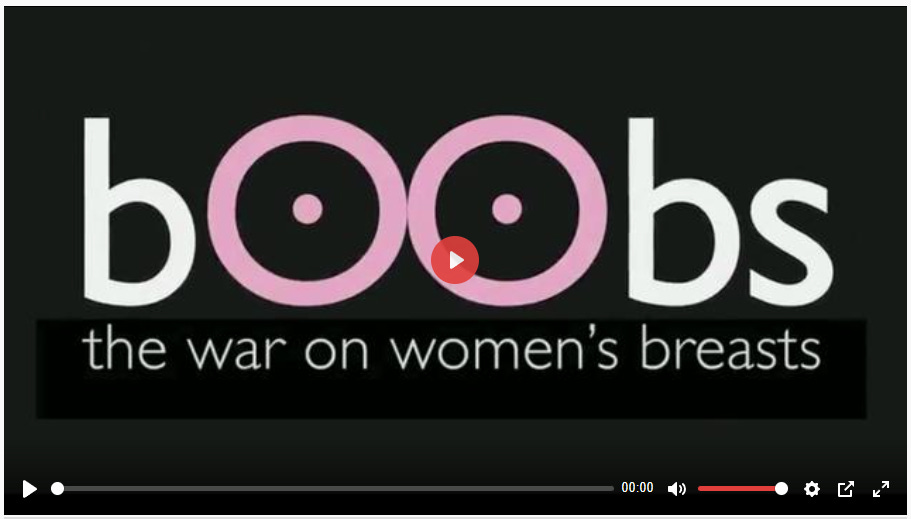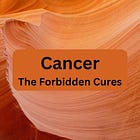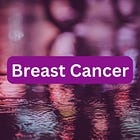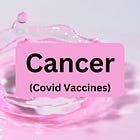Imagine I’d tell you it’s OK to project 100 days’ worth of sun rays on your house in 2 seconds. Not on the entire house, just say on your porch. Intuitively, you’d go: “Wait a minute. That’s a lot of heat, and then this is typically spread across the entire roof. Isn’t this going to burn my roof? – Marc Girardot
Tumors cannot be seen on mammograms until they number about a billion cells and have been growing for 6-10 years - rendering it useless for meaningful early detection. - Boobs [Documentary]
This all started when I read Marc Girardot’s excellent stack on mammograms.
I messaged my wife from the train, where I had just read the piece:
“Did you know that a mammogram is an x-ray!”
She messaged back instantly: Yes.
I could feel her eye’s rolling, as if I had just discovered what all women know. But I’m not convinced, I’m going to go out on a limb and suggest that most woman don’t know that it’s an x-ray.
Then, as serendipity would have it, I received this reader comment from Dan (thank you Dan) to my Breast Cancer stack:
An informative contribution to the subject comes from https://boobsdoc.com and integrates closely with an excellent book by Peter Gøtzsche, “Mammography Screening, truth, lies and controversy”, a 446-page long report which could have a subtitle like “Things you should have been taught in high school, but they considered it unimportant”.
And so, I decided to watch the documentary, that is now the corner stone of this stack.
Mammography: The War on Women's Breasts (rumble.com)
Boobs - The War on Women's Breasts (bitchute.com)
bOObs: The War on Women's Breasts (boobsdoc.com)
I was talking to my wife, shortly after watching the documentary:
“Did you know that a mammogram is the equivalent of 100 x-rays?”
This time she was quite for a moment, and then eventually said “No.”
No eye rolling this time.
Let’s start off with the documentary Boobs, and although I’m going to give you a detailed summary, it is worth your time to watch it and hear it directly from the doctors.
Boobs – The War on Women’s Breasts
Comprehensive Summary
The documentary discusses the use of mammograms for breast cancer screening, and the associated harms. It covers topics including radiation exposure from mammograms, false positives/negatives leading to unnecessary procedures, overdiagnosis and overtreatment of non-threatening cancers, conflicts of interest in the medical industry, and alternative screening methods such as thermography and ultrasound.
A key point made is that mammograms use radiation equivalent to at least 100 chest x-rays, accumulating over a woman's lifetime, and directly causing DNA damage that can lead to cancer. Studies show screening mammograms have not reduced breast cancer mortality overall, and may increase deaths in some groups. Yet they remain the standard of care, with doctors and industry interests reluctant to change protocols. Up to 30% of early detected cancers would never have progressed or impacted health, leading to traumatic and risky overtreatment.
Breast density obscures tumors on mammograms, spurring additional radiation and false positives. Yet most women are not informed about their density. Together, dense tissue and overdiagnosis doubly harm women. Meanwhile, non-radiative options like ultrasound and thermography, which detect subtle physiological changes years before tumors develop, are dismissed by convention despite accuracy nearing 99% when combined. Conflicts of interest, rigid protocols, bureaucracy, and legal risk avoidance perpetuate the system.
The documentary cautions women to research carefully, demand alternatives like ultrasound and thermography, get second opinions, know all risks and limitations before consenting to procedures, report incomplete information to authorities, and vote with their feet if doctors are not responsive. Change begins with consumer awareness and choice. This can compel the industry toward safer, more effective early detection based on biology not anatomy - preventing rather than treating breast cancer.
Key takeaways:
Mammograms use high levels of radiation, equivalent to at least 100 chest x-rays over a lifetime, accumulating dose and directly damaging DNA.
Studies show routine screening mammography has failed to reduce overall breast cancer mortality, and may increase deaths in some subgroups.
Up to 30% of early detected breast cancers would never have threatened a woman's health or required treatment.
Yet mammograms remain standard of care, exposing women to substantial harms from false positives, overdiagnosis, overtreatment, and radiation.
Most doctors and industry interests vigorously defend mammograms despite evidence, due to protocols, financial incentives, bureaucracy, legal risk, and conflicted research.
Tumors cannot be seen on mammograms until they number about a billion cells and have been growing for 6-10 years - rendering it useless for meaningful early detection.
The extremely common problem of dense breast tissue obscures tumors on mammograms and increases radiation exposure due to more images needed.
Despite law requiring notification, most women still do not know their breast density, nor how it impairs mammogram accuracy often down to just 50%.
The combination of overdiagnosis from mammograms and inability to see tumors in dense breasts doubly harms women.
Infrared thermal imaging (thermography) detects subtle physiological changes reflecting inflammation and angiogenesis in tissue years before tumors develop.
When combined, thermography and ultrasound achieve up to 99% accuracy for early detection, compared with 50% for mammograms - yet convention discounts them.
Bias, conflicts of interest, financial incentives, bureaucracy, rigid protocols and avoidance of legal risks perpetuate mammograms as standard of care despite evidence of harm.
Women must research options demand alternatives like ultrasound and thermography, get second opinions, understand limitations of tests before consenting, and report incomplete information.
Change begins with consumer awareness and choice, compelling industry toward safer, more accurate, early detection methods based on biology not anatomy - preventing rather than treating advanced cancer.
Routine, close self-examination enables women to know their breast health and identify abnormalities early while minimizing medical radiation risks.
As imaging technology progresses, breast thermography and ultrasound will likely surpass mammography for safe, low-cost, early detection and prevention monitoring.
Breast cancer screening should shift to emphasize breast health and early physiologic changes, rather than anatomy and advanced tumors.
Focus must turn to primary prevention - ending refined carbohydrates, processed foods, xenoestrogens etc. along with periodic early screening.
Men would likely refuse a standard test as invasive and harmful as routine mammograms if it were applied to a sensitive male body part.
Doctors, regulators and legislators must make women's breast health a priority, ending biased misinformation and access barriers to better early detection methods.
Breast cancer detection and treatment cannot progress substantially until consumers unite to demand an end to institutional inertia, rigid protocols and conflicted interests that do more harm than good.
Quotes:
”Mammograms cause breast cancer period...if you don't want breast cancer don't get a mammogram.”
”Come on colleagues, let's get back to have a practical sense behind some things and not allow ourselves to be a part of a system that we truly see is destructive.”
”When women realize...it is a harmful thing, rather than a helpful thing, do you think that we would continue to choose to do that thing most of us know.”
”It breaks the consumer protection laws ultimately probably does...that patient doesn't have all the information.”
”We believe that patients supposed to have a choice...I know want to have radiation.”
Statistics:
Mammograms use radiation exposure equivalent to at least 100 chest X-rays over a lifetime.
Up to 50% of actual cancers are missed by mammograms, and up to 80% of women screened receive no mortality benefit.
10 to 40% of early detected breast cancers would never have presented a threat or required treatment if left undetected.
For the 40-50% of women with dense breasts, mammogram accuracy is often less than 50% due to obscured tumors.
Thermography and ultrasound together achieve 95 to 99% accuracy for early detection of breast tumors.
Tumors cannot be seen on mammograms until reaching about 1 billion cells in size after 6-10 years of undetected growth.
Modeling predicts up to a 50% increase in breast cancer rates by 2030, to over 350,000 annually in the US up from 240,000 currently.
Starting mammograms before age 50 and continuing past age 75 results in 5 to 20% lifetime risk of mammography inducing fatal cancer.
I took so much from the documentary, and I especially enjoyed listening to Dr. Ben Johnson, author of:
No Ma'amograms!: Radical Rethink on Mammograms: Johnson, Dr. Ben
Written by acclaimed integrative oncologist Ben Johnson, MD, DO, NMD, No Ma’am-ogram! Radical Rethink on Ma'amograms refutes the medical myths and fallacies at the root of today’s conventional breast health care protocols, offering readers safer solutions to breast cancer prevention, diagnosis, and treatment.
Dr. Ben discusses the new research behind practical and effective alternatives to harmful mammograms, biopsies, radiation and chemo therapies. His holistic approach includes recommendations on diet, exercise, nutritional supplements, and lifestyle changes to counteract the effects of dangerous toxins and medical practices that create the harmful conditions in which breast cancer can arise. Through a wealth of facts, exposés, and preventive tips, this definitive guide shows every woman how to move toward better health maintenance for the breasts and body.
Documentary Highlights
Some interesting moments for me in the documentary were at minutes:
4.24
As part of Carla’s story, they talk about how a stable cancer can be made to spread by the mammogram and biopsy combination.
6.36
Squeezing the breast will create an inflammatory change.
7.06
If you do a biopsy and then compress the breast it’s going to squeeze out of the hole.
38.00
X-ray radiation can convert in the tissue into heavy metal. – Dr. Gloria Jackson
38.49
The breast is the most radio sensitive organ a woman has. – Dr. Manfred Doepp.
39.10
Radiation creates free radicals and oxidative stress.
43.50
“…about as much radiation as flying across the country…” – Industry propaganda and nonsense.
46.00
Dense breasts absorb 3 to 5 times more radiation.
46.32
The risk of inducing cancer is higher than the risk of preventing cancer if you do a mammogram each year.
47.40
Switzerland abolished mammography as a routine method.
Why are the Swiss Abolishing Mammograms? - WayMark Productions
Why are mammograms banned in Switzerland? (expresshealthcaremgmt.com)
Switzerland debates dismantling its breast cancer screening programme | The BMJ
A row has erupted in Switzerland after the Swiss Medical Board recommended that the country’s mammography screening programme for breast cancer be suspended because it leads to too many unnecessary interventions.
In a report made public on 2 February, the board said that while systematic mammography screening for breast cancer saved 1-2 women’s lives for every 1000 screened, it led to unnecessary investigations and treatment for around 100 women in every 1000.
50.19
If you start doping mammograms at about 48 each year to 80, the probability that you will get an induced cancer grows from 5% to 20%.
50.54 – Refers to this study
Recent radiobiological studies have provided compelling evidence that the low energy X-rays as used in mammography are approximately four times--but possibly as much as six times--more effective in causing mutational damage than higher energy X-rays. Since current radiation risk estimates are based on the effects of high energy gamma radiation, this implies that the risks of radiation-induced breast cancers for mammography X-rays are underestimated by the same factor.
51.16
When x-rays pass through the body, some get absorbed while the rest passes through. High energy x-rays tend to penetrate fully with minimal absorption, while low energy x-rays get more readily absorbed.
Specifically, if a high energy x-ray beam enters the body, about 90% will exit while just 10% gets deposited. However, for a low energy x-ray beam, only around 40% exits and 60% gets absorbed as radiation dose.
Therefore, using the same initial radiation intensity, lower energy x-rays will result in higher body-retained radiation load. Since mammograms utilize relatively low energy x-rays that get significantly absorbed by soft breast tissue, they carry very high instantaneous radiation dose concentrations per gram of tissue exposed.
53.33
Women that get mammograms die more often than women that don’t – The Lancet
54.10
Mammograms cause breast cancer…period.
59.24 – Thermography
Thermography is a safe, non-invasive, and painless FDA-approved adjunct breast screening test involving an infrared camera to visualize heat patterns.
It does not use radiation, compression between plates, or any direct contact with the breasts whatsoever - vastly more comfortable than mammograms.
Thermography is significantly less expensive than mammograms or other anatomical imaging methods.
As an infrared heat sensor, it provides unique physiological data unobtainable from traditional anatomical tests like mammograms or MRIs.
Specifically, thermography can reveal subtle inflammation, circulatory abnormalities, lymphatic congestion, and other functional changes reflecting very early emerging health issues years before tumors would be visible.
By detecting the earliest stages of physiological dysfunction, thermography allows the best chance for preventative actions, lifestyle changes, or treatment interventions to correct dysfunction before disease advances.
Here is Dr. Robert Yoho on mammograms.
I was wrong about "healthcare". - Lies are Unbekoming (substack.com)
Mammograms.
What I thought: mammograms save women from breast cancer.
The truth: Mammograms used to check women without lumps or other indications are a waste of time, money, and emotional energy. Millions of these tests are performed each year, hundreds of thousands of them are positive or unclear, and untold women get repeated mammograms and ultrasound examinations to chase the findings. After this, biopsies and surgeries are done to evaluate and cut out the areas of concern.
This process is expensive, and each procedure is a little risky.
But the math does not work—patients do not live longer after accounting for the hazards of the invasive procedures that ensue after a mammographic finding. We would be better off if the system only evaluated women with lumps, they find themselves.
Clearly there is something rotten within Mammography.
But by now it is the usual story and the usual suspects.
An idea that becomes a norm that has billions of dollars of careers, mortgages, reputations and lobbying behind it.
With the usual captured journals, the presstitutes, laundering and lying to the public.
But I’m not surprised anymore.
Mammograms fail the NSE three legged stool test that I submit all medical interventions to nowadays.
Remember you only need one leg of the stool to fail.
Necessity - FAIL
They are overused, and there are cheaper and safer and more accurate alternatives.
Safety – FAIL
It’s high dose radiation causing tissue damage, oxidative stress, and cancer.
Effectiveness – FAIL
Well, you can see from the statistics above, it has an extremely high false positive and false negative rate. Again, compared to the alternatives available, it is incredibly ineffective.
Three out of three FAILS.
No wonder the FDA loves it.
I’ve said it before, and it’s apt to say it again.
Of the two sexes, women are far and away the more abused and mutilated of the two sexes by Big Medicine.
Peter Gotzsche has written a whole book on the subject.
Mammography Screening: Truth, Lies and... by Gotzsche, Peter
'This book gives plenty of examples of ad hominem attacks, intimidation, slander, threats of litigation, deception, dishonesty, lies and other violations of good scientific practice. For some years I kept a folder labeled Dishonesty in breast cancer screening on top of my filing cabinet, storing articles and letters to the editor that contained statements I knew were dishonest. Eventually I gave up on the idea of writing a paper about this collection, as the number of examples quickly exceeded what could be contained in a single article.'
From the Introduction
The most effective way to decrease women's risk of becoming a breast cancer patient is to avoid attending screening.
Mammography screening is one of the greatest controversies in healthcare, and the extent to which some scientists have sacrificed sound scientific principles in order to arrive at politically acceptable results in their research is extraordinary. In contrast, neutral observers increasingly find that the benefit has been much oversold and that the harms are much greater than previously believed.
I started with Girardot and want to end with him.
Here is an important passage from his article on his calculation regarding the excess radiation the breast cell tissues are exposed to.
Mammogram Informed Consent Travesty - by Marc Girardot (substack.com)
So to understand, if a stem cell can get poisoned by a mammogram and occasionally trigger cancer, one needs to normalize the dose received by time and by mass. What that means is calculate how more intense the beam is going to be for the breast cells. And I found 400 million times more!
If 2 breasts each having 2 scans take on 0.4 milliSiverts, that’s 0.5 µSieverts per gram of breast tissue per second (µ stands for micro, a millionth of), and that is indeed more than 400 million times more. That doesn’t necessarily make it dangerous, but clearly we never evolved for doses that high, and the narrative is truly misleading.
Here is a summary of his article on the subject:
Girardot questions why breast cancer rates are disproportionately high compared to other cancers, despite lungs being larger organs that should have greater exposure to potential carcinogens. This defies the "Bolus theory" which links accidental IV injections to increased cancer risk.
He hypothesizes that mammograms may be contributing to increased breast cancer rates by exposing breast tissue to high intensity radiation levels - up to 400 million times higher dose per gram of tissue than normal background radiation. This could be triggering excess stem cell replication as a protective mechanism, leading to uncontrolled tumor growth.
Specifically, he calculates that the 0.4 mSv mammogram radiation dose, while deemed generally safe, delivers an instantaneous intensity per gram of breast tissue that is 400 million times higher than average annual background radiation. He argues this intensity has never been experienced through evolution, so its effects cannot be casually dismissed.
The theory is that radiation insult could poison vital stem cells, which then rapid-replicate to dilute damage, creating over 128 excess stem cells from just one insulted cell. This exponentially compounds risk of errors leading to aggressive "triple negative" cancers.
Girardot advises women to consider ultrasound instead of mammograms given this risk, lack of informed consent around intensity, and the massive 50% rise in breast cancer incidence over 50 years that remains unexplained. Ultimately better public health research is needed on causes, as well as potential techniques in mammogram delivery that could mitigate unintended radiative stem cell damage.
Thermography resources:
US
Find a Thermography Center - Breast Thermography | Breast Thermography
Australia
Advanced Thermography - Mobile Imaging Services, Breast Scan and Naturopathic Advice
More Cancer Resources from this Substack.
Thanks for being here.
Please consider a paid subscription.
You will get nothing more for your support, as everything is made freely available. The money simply goes towards recovering some of the cost of this work.
I am always looking for good, personal GMC, covid and childhood vaccination stories. You can write to me privately: unbekoming@outlook.com
If you are Covid vaccine injured, consider the FLCCC Post-Vaccine Treatment
If you want to understand and “see” what baseline human health looks like, watch (and share) this 21 minutes
If you want to help someone, give them a book. Official Stories by Liam Scheff. Point them to a “safe” chapter (here and here), and they will find their way to vaccination.
Here are all eBooks and Summaries produced so far:
FREE Book Summary: The HPV Vaccine on Trial by Holland et al.
FREE Book Summary: Bitten by Kris Newby (Lyme Disease)
FREE Book Summary: The Great Cholesterol Con by Dr Malcolm Kendrick
FREE Book Summary: Propaganda by Edward Bernays
FREE Book Summary: Toxic Legacy by Stephanie Seneff (Glyphosate)
FREE Book Summary: The Measles Book by CHD
FREE Book Summary: The Deep Hot Biosphere by Thomas Gold (Abiogenic Oil)
FREE Book Summary: The Peanut Allergy Epidemic by Heather Fraser
FREE eBook: What is a woman? - “We don’t know yet.”
FREE eBook: A letter to my two adult kids - Vaccines and the free spike protein











A famous surgeon who was my father's mate, my father was a doctor, told me many times never to go for "routine" check of any kind.
He said " you go for a check when you ARE sick, before it is not only useless, it is dangerous. Too many of the checks they do are dangerous."
I did my first mammogram ten years ago. It was so traumatic -- painful and needlessly frightening due to its inaccuracy -- that I refused to get another one, even though I was pressured heavily every year from my gyno.
A brilliant naturopath I used to work with told me that breast tissue acts like a filter for the female body, much like the liver, which is why environmental toxins affect breast cancer rate. She said the prostate performs the same function in men.
The medical profession has been reduced to a bunch of technologists. All they're really good at now is anything mechanical -- heart transplants, broken bones, etc. Healing is not a machine, its an art.
Thanks for bringing awareness forward! The documentary sounds terrific...